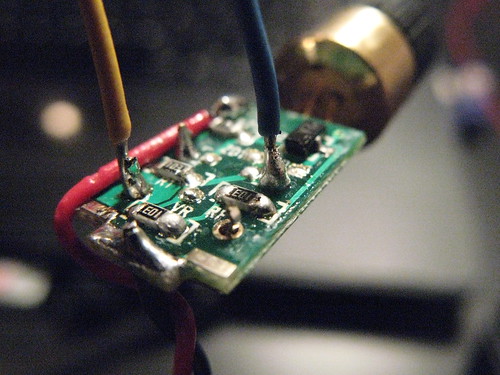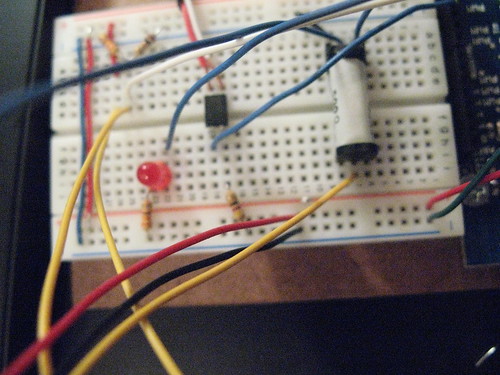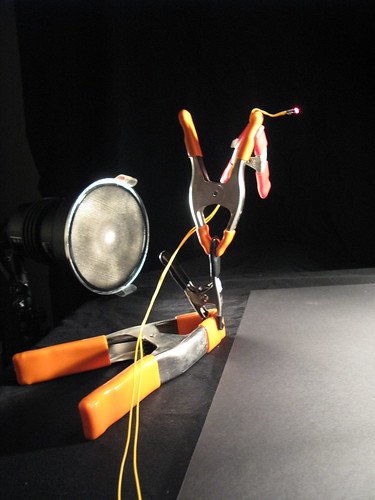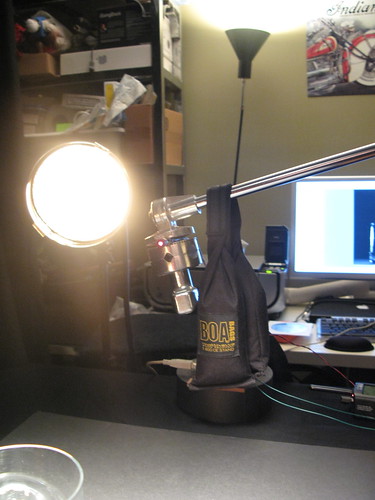Laser Activated
By Vikram Tank on August 2008, Day 2

Today for my 5 in 5 project I assembled a trigger for camera flashes that is activated by a laser and used it to take some photos of a piece of ice landing in water. I have wanted a device like this for a very long time. A laser trigger allows you to fire a camera or a flash when a object breaks the laser beam. It is essential for high speed photography, and it makes other photo tasks such as position based photography possible. I am mainly interested in it for taking still life photos. I also needed to have my unit interface with the Pocketwizard triggering system that I currently use.
I had done some hunting in my early photo career and heard that at RIT there is an entire class on high speed photography. Also I heard there’s a guy there that makes his own laser triggers. I thought what an electronic genius. I also looked at commercial laser triggers, but they are very expensive (http://www.kapturegroup.com/kap_htmls/laser.html). I found a simple solution a few months ago on Maurice Ribble’s site Glacial Wanderer. He has made a simple trigger using the Arduino and a Sparkfun laser module as well as many other photo triggers (lightning and sound will be my next projects soon). I loved his use of simple materials and have wanted to build one for a while.
I started by finding a laser module to hack. As time was of the essence I was forced to buy my laser pointer from Staples, but i think a cheap 4 dollar laser pointer would work just as fine, and I would have preferred it. I started by taking the laser module out of the laser pointer with some delicate screw driver work. It looks like the below outside of the big case.


I desoldered the power bar and the spring for the ground (the spring steel in my pointer was very strong and cannot be cut with regular wire snips without damaging them).

After removing those parts I was able to solder on new ground and power wires. There is also a switch on the laser pointer that I wanted to bridge because I wanted the Arduino to be able to control whether the laser pointer was on or off.

After that a quick assemble of Maurice’s circuit. I added a relay to control my laser pointer. You omit this by bridging the switch terminals with a piece of wire going from one to the other. If you chose to do that then you will control the laser by switching its power on and off.


After the build I took the setup home and used it to take the ice cube falling shots. I set up the lights and the glass of water on a black background ( please be careful if you try this, photo lights and water are not friends). I set up the laser trigger in like below. I didn’t have a clamp to hold the sensor high enough so I had to jury rig one out of several clamps.

The laser itself was held in the knuckle of a c-stand. I’ll take a moment to tell you that it is very important that you weigh down and stabilize the stands holding the laser and receiver. If they fall out of alignment they can repeatedly trigger the flash.

I also set up two lights from behind to light the glass, and one from above for overall illumination. I was careful not to let any light onto the background.

After initial setup I started shooting. I shot at 2 seconds at f11. I would trigger the shutter after turning off the modeling lights on the strobes. Also my studio was fairly dark at the time so there was no issue with ambient light. If I was shooting during the day I would have had to black out windows if the ambient exposure caused problems at the meter reading above. After the first shot I noticed that the flash was firing too early. The problem with the flash firing so early was that it froze the ice cube in mid air, but did not catch the splash. I added a delay to Maurice’s code of 100 milliseconds and this fixed that problem. A second problem is that the laser would register in the shot after the flashes fired and the water was in the air. I rectified this by delaying the laser turning back on in his code by one second. After this the shots were amazing and exactly what I wanted.
Well not exactly. My flash units are profoto acute2 heads driven by a profoto acute2 2400 generator. The flash duration on these units is not as short as a more expensive unit by Broncolor and so the water droplets are not as frozen as I’d like them to be. I’ve know the flash duration on some Nikon Speedlights is very short and I’d like to try these as well.
If you click through, you can look at a larger size of the image below.

July 30th, 2008


5 Comments
Add your own1. Corey Menscher | July 30th, 2008 at 1:06 pm
Dude this is phenomenal! Great work! I can’t wait to see more. Can you provide the shots at a higher resolution somewhere?
2. John Dimatos | July 30th, 2008 at 1:43 pm
holy. majoles. of. hermes.
that’s awesome.
3. 5 in 5 com Laser Activate&hellip | May 31st, 2009 at 7:24 pm
[...] 5 in 5 com Laser Activated Posted by root 2 hours 5 minutes ago (http://5-in-5.com) Jul 30 2008 the laser itself was held in the knuckle of a c stand leave a comment name required email required hidden powered by wordpress website by david steele overholt theme modified from box set Discuss | Bury | News | 5 in 5 com Laser Activated [...]
4. Ru Macd | June 14th, 2009 at 1:57 pm
what part of the camera do you trip when the contact is closed? cos im going to make one of these.
5. Derek Hatfield | July 22nd, 2009 at 10:10 pm
Can you make me one? Or provide VERY simple step-by-step instructions with parts need, etc.
Thanks,
derek
Leave a Comment
Trackback this post | Subscribe to the comments via RSS Feed